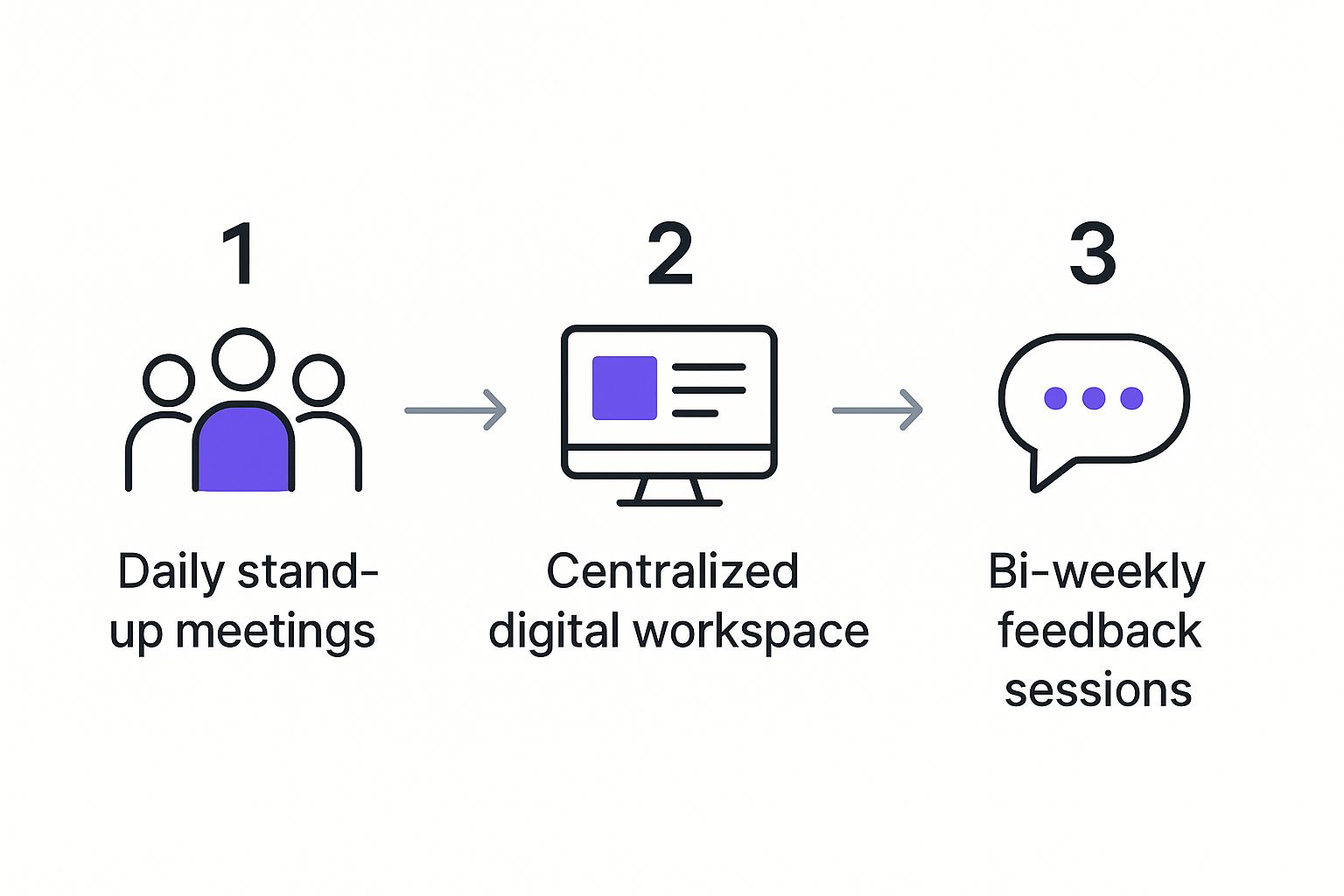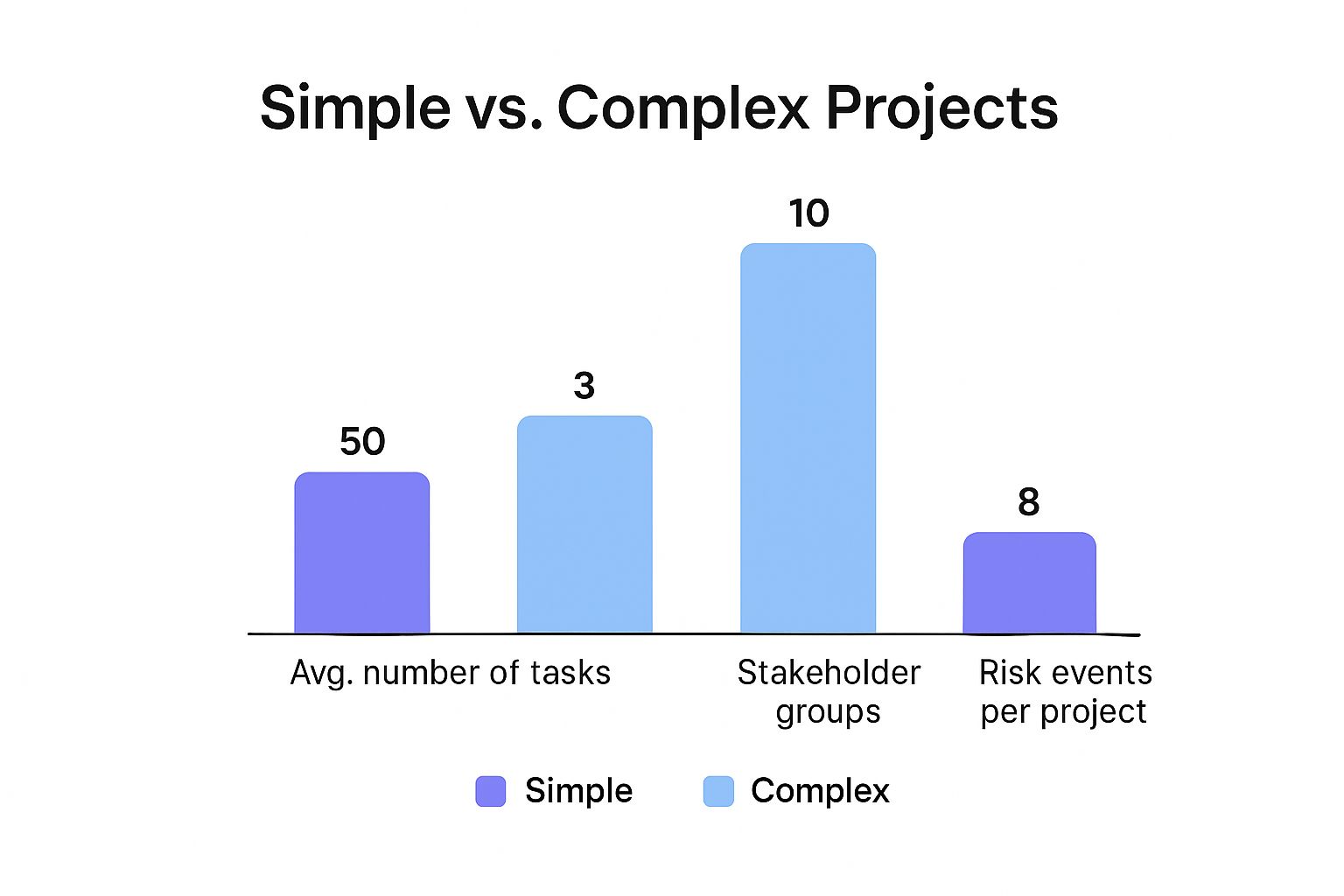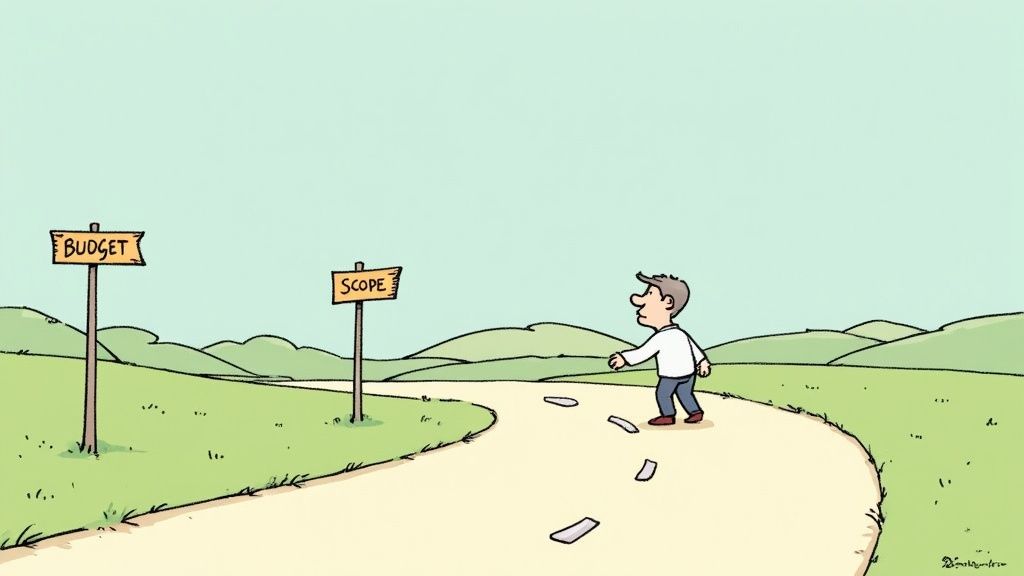You cannot buy a high-performing team off the shelf. It is not about flashy software or chasing the latest management fad. The truth is that incredible team performance is an outcome, not something you can just plug in. It all begins with getting crystal clear on what success looks like for your organisation, in real, measurable terms tied directly to your business goals.
The True Foundation of a High-Performing Team

Before we discuss aligning goals or tweaking workflows, we have to talk about the bedrock of any great team. This is the one thing that, if it is missing, makes everything else fall apart. We are talking about psychological safety and trust.
At Yopla, we see it time and again. What holds teams back is not a shortage of talent; it is a culture of fear. When people are afraid to speak their minds, admit they have made a mistake, or challenge an old way of doing things, you do not get commitment. You get compliance. Innovation grinds to a halt, and the best ideas never see the light of day.
How to tell if your team has trust.
How can you know if your team genuinely feels safe? It is not a metric you will find on any dashboard. It takes honest reflection and the courage to ask some tough questions.
Think about your last few team meetings. What was the real dynamic in the room?
- Do people openly, and constructively, disagree with each other? Or even with you?
- When a project goes sideways or a deadline gets missed, is the immediate reaction to find someone to blame, or to figure out what went wrong with the process?
- Are team members quick to ask for help when they are stuck, or do they struggle in silence, worried they will look incompetent?
Your gut answers to these questions will tell you everything you need to know about the level of trust in your team. If the answers make you a bit uncomfortable, that is a great starting point. It means you have pinpointed the single biggest obstacle to building a truly high-performing team.
Key Takeaway: A team without psychological safety will never hit its full potential. It is just a group of individuals managing their own personal risk, not a unified force driving towards a common goal. This is not a "soft skill". It is the fundamental operating system for collaboration and innovation.
How to build an environment of safety.
Creating this kind of environment must start at the top. As a leader, you must be the first to model the behaviour you want everyone else to adopt. When you make a mistake, own it openly. When someone pushes back on your idea, thank them for their candour. This gives everyone else the permission they need to do the same.
Another vital piece of the puzzle is truly understanding the people on your team. People feel safer and more connected when they know their unique perspectives and working styles are seen and valued. This is so important, and you can dive deeper into harnessing personality diversity to elevate the workplace in our detailed guide.
Building trust is not a one-off task. It is a continuous practice, something you weave into every single meeting, decision, and process. It is about creating a space where people can show up as themselves, take smart risks, and work together without fear. Only then can you start the real work of aligning everyone on a shared purpose and designing systems that empower them to succeed.
Aligning Your Team with a Shared Purpose

A team without a shared purpose is just a group of individuals who happen to work in the same office or show up on the same video call. True high performance only kicks in when that group becomes a unified force, all pulling in the same direction because they genuinely understand and believe in the end goal.
This is not about having a generic mission statement gathering dust on a wall. It is about translating your organisation's high-level vision into clear, tangible goals that mean something to every person on the team. The real work is connecting the dots so that everyone, from the COO to the newest hire, sees exactly how their daily efforts contribute to the bigger picture. That is how you create a powerful sense of ownership.
From conflicting goals to unified objectives.
We once worked with a professional services firm where the sales and delivery teams operated with opposing targets. The sales team was bonused on total contract value, while the delivery team's performance was judged on project margin and client satisfaction.
You can probably guess what happened. Sales would promise the moon to close a big deal, leaving the delivery team to grapple with unrealistic client expectations and wafer-thin margins. The internal friction was immense, and the quality of work was suffering. The problem was not the people; it was the broken system they were forced to work within.
Our solution was to get both teams in a room to build a new, unified goal together. We guided them to shift their focus from separate departmental targets to one shared objective: profitable, referenceable clients.
This simple change had a profound effect.
- Sales started qualifying leads more carefully.
- Delivery began providing crucial input during the proposal stage.
- Communication lines opened up because they were suddenly solving problems together.
They stopped functioning as two separate departments and started acting like a single, cohesive revenue team. By aligning their purpose, they slashed internal conflict and saw a huge improvement in both profitability and client happiness.
A team's effectiveness is often dictated by its structure. Research from Gallup shows that managers account for a staggering 70% of the variance in team engagement. While over half of UK employees have individual goals, only 36% have clearly defined team-level goals. The most successful teams bridge this gap by integrating individual, team, and customer objectives into a coherent whole. Discover more insights on the science of high-performing teams from Gallup's research.
A framework for co-creating goals.
You can build this alignment capability directly within your teams. It does not require complex software or a huge budget, just a structured, inclusive conversation. The trick is to make goal-setting a collaborative exercise, not a top-down directive.
Here is a simple framework we have used to run these sessions effectively:
- Start with the 'Why'. Kick things off by clearly restating the organisation’s main objective for the quarter or year. Ask: What is the single most important thing we need to achieve?
- Translate to team impact. Now, turn it over to the team. Ask them: "For the company to hit that target, what must our team deliver?" This is a brainstorming phase to get all possible contributions on the table.
- Define 'What' and 'How'. Next, you will want to shape those contributions into specific, measurable objectives. For each one, define what success looks like and how you will track progress. This creates a direct line of sight between daily actions and the final outcome.
- Assign ownership. Make sure every single objective has a clear owner. This is not about playing the blame game later on. It is about creating accountability and a clear point of contact for everyone involved.
When you facilitate this kind of process, you are doing much more than just setting goals. You are building collective intelligence and fostering genuine shared ownership. People are always more committed to plans they have had a hand in creating. This approach ensures the capability to align stays within your team, making them far more adaptable and resilient long after we have left the room.
The Leader's Role in Cultivating Performance

It is easy to think a manager’s job is just to oversee tasks. But great managers know they are performance cultivators. In fact, leadership is the single most powerful lever you have for building a high-performing team. From our experience, the gap between an average manager and an exceptional coach boils down to a few tangible, repeatable behaviours.
The biggest shift you can make is moving from being a ‘director’ of work to a ‘facilitator’ of success. A director tells people what to do. A facilitator, on the other hand, asks the right questions, clears obstacles, and creates an environment where the team can find the best path forward themselves. It is a subtle change, but it is what truly unlocks a team’s potential.
From director to coach.
What does it mean to be a facilitator? It means you stop being the source of all the answers. Your role is to guide your team to find them on their own, moving from instruction to inquiry.
Imagine a team member hits a roadblock. A director might say, "Here is how you solve that." A coach, however, asks, "What have you tried so far? What do you think the next step should be?" This approach does not just solve the immediate problem; it builds lasting problem-solving skills and confidence.
Your one-on-one meetings are the perfect arena for this transformation. All too often, these are just glorified status updates. A coaching-focused one-on-one should spend less than 20% of the time on project status. The rest should be dedicated to their development, challenges, and career aspirations.
Key coaching questions for one-on-ones.
The most impactful leaders we have worked with consistently ask three simple questions:
- What are you most proud of this week? (Focuses on wins and boosts morale.)
- Where are you feeling stuck or frustrated? (Uncovers hidden blockers.)
- How can I better support you? (Positions you as an ally.)
This structure reframes the entire conversation around the individual, not just their to-do list. It builds trust and gives you the insight you need to clear the path for them.
The power of effective feedback and delegation.
Feedback is another area where leaders can either build people up or shut them down. Any constructive feedback you give must be specific, behavioural, and focused on impact. Ditch vague statements like "be more proactive" and focus on observable actions and their direct consequences.
Delegation is not just about offloading work; it is a powerful development tool when used correctly. Instead of just assigning a task, frame it as a growth opportunity. Explain why you chose them, what skills you hope they will develop, and what a great outcome looks like. This turns a simple assignment into a meaningful investment in their career. For leaders looking to add more structure, designing an effective performance management system is a crucial step.
The impact of this kind of management is not just anecdotal. The UK’s Management and Expectations Survey revealed that firms with better management practices excel at goal-setting, performance monitoring, and employee development. With a national average management score of just 0.55 out of 1, the data confirms that improving leadership through better coaching and feedback is a massive opportunity for UK businesses. You can explore the full findings from the Office for National Statistics.
Manager self-assessment checklist.
Becoming a better leader is an attainable skill, not an innate trait. To help you pinpoint your own growth opportunities, take a moment for an honest self-assessment.
Rate yourself on a scale of 1 (Needs Work) to 5 (Consistent Strength):
- Clarity. My team can clearly articulate our top priorities without my help.
- Coaching. I spend more time asking questions than giving answers in one-on-ones.
- Feedback. I give specific, constructive feedback regularly, not just during formal reviews.
- Delegation. I delegate tasks with the specific intention of developing a team member’s skills.
- Trust. My team members are not afraid to tell me when they have made a mistake.
Use your answers to identify one or two areas to focus on over the next quarter. Small, consistent improvements in your leadership approach will create a ripple effect, elevating the performance and engagement of your entire team. This is how you build capability that sticks.
Designing Systems That Empower Your Team
You can have the most talented, driven team in the world, but they will hit a wall if they are constantly fighting against clunky processes and disjointed systems. High performance is not just about people. It is about creating an environment that removes friction, rather than creating it. Think about it: if your team spends its days hunting for information across five different platforms, that is energy they cannot spend on valuable, meaningful work.
At Yopla, we have learned that technology and processes have to serve the team, not the other way around. It is a common mistake for organisations to buy a shiny new piece of software, hoping it is a silver bullet for their problems. But technology is an amplifier. If your underlying processes are a mess, a new tool will just digitise that mess.
A people-first approach to process improvement.
The secret to designing systems that actually work? Get the people who use them every single day involved in the design process. Instead of dictating a new workflow from on high, bring the team together to audit it collaboratively. This approach does not just lead to better solutions; it builds a powerful culture of ownership and continuous improvement.
Pick one critical process that is causing a lot of friction. It could be anything from client onboarding to your monthly reporting routine. Then, gather the team to map it out together.
- Map the current state. Ask everyone to walk through the process as it exists right now, step-by-step. Who is responsible for what? Which tools are involved? Where does key information actually live?
- Find the bottlenecks. As you map it out, prompt them with questions like: Where does this feel slow? At what point do things get frustrating or stuck? Where do we consistently have to redo work?
- Design a better way. With the pain points clearly identified, shift the conversation to solutions. Encourage them to think big: What if we could get rid of this step entirely? What if this information was always available right here?
Suddenly, the dynamic shifts from complaining about broken systems to proactively building better ones. You are embedding operational improvement into the team's DNA, giving you a lasting sense of digital sovereignty.
Creating a single source of truth.
One of the biggest productivity killers we see is information chaos. When crucial data is scattered across emails, spreadsheets, and endless chat threads, your team spends more time searching than executing. A cornerstone of building a high-performing team is establishing a single source of truth for all critical information.
This does not mean you need one enormous, all-encompassing system. It is about creating a central, agreed-upon hub where plans, goals, and progress are visible to everyone. At Yopla, our Plans Portal serves this exact purpose. It is a straightforward, shared space that makes change visible and keeps everyone accountable. No more wondering where to find the latest update. That clarity frees up mental energy and sharpens decision-making.
By creating a single, shared view of work, you eliminate the operational fog that leads to duplicated effort and misaligned priorities. This clarity allows your team to focus their collective intelligence on solving problems, not chasing down information.
The process flow below shows a simple but incredibly effective communication and feedback loop.

This kind of structure ensures that daily work stays connected to the bigger picture, is visible in a central workspace, and is constantly refined through regular feedback. It is a practical system for fuelling high performance. When your systems are truly designed to empower your people, they become an engine for growth instead of an anchor holding you back.
Keeping the Fire Alive: Growth, Recognition, and Lasting Momentum
Getting a high-performance team off the ground is one thing; keeping it flying is another matter entirely. This is not a "set it and forget it" task. You have worked hard to build psychological safety, unite everyone under a shared purpose, and get your systems running smoothly. Now, the real work begins: nurturing that environment so your team can thrive for the long haul.
It is a common trap to think a competitive salary is the be-all and end-all. Of course, you have to pay people fairly. That is the price of entry. But what truly keeps your best people from looking elsewhere is the feeling that they are seen, that their work matters, and that they have a future with you.
More than money: what meaningful recognition looks like.
Let us move beyond the tired "employee of the month" plaque. For recognition to actually work, it needs to be specific, timely, and authentic. It is about catching people doing things right, celebrating not just the headline-grabbing wins, but the smart risks, the collaborative moments, and the quiet, consistent effort that drives real progress.
How do you build this into your team's DNA? Here are a few ideas we have seen work wonders:
- Peer-to-peer praise. Create channels where team members can publicly thank and acknowledge each other. A shout-out from a respected colleague often means more than one from the boss.
- Celebrate the learning, not just the win. Did someone master a new piece of software or bounce back from a tough challenge? Acknowledging that effort shows you value growth as much as you value results.
- Connect the dots to real-world impact. Make it a habit to show how the team's work is directly helping a client or moving the business forward. A genuine sense of purpose is a powerful, renewable energy source for any team.
The data backs this up. Firms that link performance to their pay programmes report 1.4 times higher employee productivity and are 1.2 times more likely to outperform their rivals. And with UK real wage growth often lagging, these non-financial rewards are more important than ever. Considering 72% of UK employees would prefer to stay put, creating a culture of recognition is a powerful retention tool. You can find more useful UK HR stats over at Let's Talk Talent.
Investing in your people creates a virtuous cycle.
The most adaptable and successful teams we have worked with have one thing in common: they are full of learners. Your people are hungry to grow their skills, and when you invest in their development, you kickstart a powerful loop where individual improvement fuels the entire team's performance.
This is not about ticking boxes with generic training days. It is about having honest conversations. The best place for this is during one-to-ones. Instead of just reviewing past performance, ask about their career goals. What skills do they feel they need to get there? This simple shift turns a review into a collaborative planning session.
By making development a shared responsibility, you foster a sense of ownership. When an employee helps define their own growth path, their commitment to it skyrockets. This is how you build capability that stays within your organisation.
Once you know what is needed, you can provide targeted support. Maybe it is a mentorship with a senior colleague, an online course to master a specific tool, or the chance to lead a small-scale project. This shows you are investing in them as individuals, not just as cogs in a machine. This is particularly crucial for big, strategic goals. For instance, understanding how digital transformation and the journey to net zero will shape your business requires new skills and a real commitment to learning.
At the end of the day, sustaining a brilliant team comes down to creating a place where people can bring their best selves to work and genuinely see a future for themselves. Prioritise recognition and growth, and you will not just build a successful company. You will build a resilient one that people are proud to be a part of.
Common Questions About Building Great Teams
When you set out to build a truly high-performing team, a lot of practical questions naturally come up. Leaders want to know what to expect, what to watch out for, and where the common tripwires are hidden. Having guided countless organisations just like yours through this process, we have put together some straight-talking answers to the questions we hear the most.
How long does it take to see a real difference?
This is usually the first question on everyone's mind, and the honest answer is that there is no magic number. However, you absolutely should be looking for early signs of progress. If you are consistently applying these principles, you ought to see tangible shifts in your team's dynamics within the first 90 days.
What do these early wins look like?
- Meetings and daily catch-ups become clearer and more efficient.
- You will notice a real drop in friction between individuals or departments.
- Team members start asking for help more openly, a sure sign that psychological safety is growing.
As for the bigger, measurable shifts in your core business KPIs, things like productivity, client satisfaction, or project cycle times, those typically start showing up within about six months. The trick is to see this as a journey of continuous improvement, not a one-off fix.
At Yopla, our scoped and phased approach is specifically designed to deliver tangible wins early. This builds crucial momentum and demonstrates value, making it easier to commit to the long-term work of creating sustainable high performance.
What is the biggest mistake leaders make?
Without a doubt, the single biggest mistake we see is leaders trying to fix the symptoms instead of the root cause. It is incredibly tempting to jump straight to a quick fix, like buying new project management software or shuffling roles around. These actions feel decisive, but they rarely solve the underlying issue.
More often than not, the real problems are human ones.
- A fundamental lack of trust or psychological safety.
- Vague or conflicting goals that just create confusion.
- Inconsistent leadership that fails to model the behaviours they expect from others.
Think of it this way: technology and processes are powerful amplifiers. They will magnify whatever is already there, good or bad. If you have a culture of blame, a new tool will just make it easier to point fingers digitally. Lasting improvement always starts with the human element. Get people communicating, making decisions, and feeling valued first. Only then will any new tool or process stand a chance of succeeding.
How do these principles apply to remote or hybrid teams?
The core principles of trust, purpose, and clear systems do not change one bit for remote or hybrid teams. In fact, they become even more critical. What must change is the level of intentionality you bring to applying them. You simply cannot rely on bumping into someone in the kitchen to build rapport or clear up confusion anymore.
In a remote or hybrid world, you have to be far more deliberate.
- Psychological Safety. This needs to be actively nurtured through structured check-ins, transparent communication channels, and leaders who are disciplined about making space for every voice to be heard.
- Shared Purpose. Goals and priorities must be meticulously documented in a central, easily accessible hub. A ‘single source of truth’, like our Plans Portal, becomes non-negotiable for keeping everyone aligned.
- Leadership. Effective remote leadership is less about monitoring activity and more about measuring outcomes. It demands a higher degree of trust and a laser focus on empowering your team to deliver, wherever they are.
The foundations remain the same, but the execution has to be adapted for a digital-first environment where clarity and trust cannot be left to chance.
How should I handle an underperformer in a team?
Ignoring an underperformer is one of the fastest ways to destroy the trust and morale of a great team. It signals that standards are not applied equally, which is deeply unfair to everyone who is consistently delivering. The key is to tackle the issue decisively but with support.
First things first, schedule a private, candid conversation. Your goal is to get to the root of the problem. Is it a genuine skill gap? A personal issue bleeding into their work? Or are they just disconnected from their role and feeling unmotivated?
Once you have a clearer picture, work together to create a simple, time-bound improvement plan. This should outline specific, measurable goals and define what support you will provide, whether that is extra training, mentorship from a peer, or regular coaching sessions. This approach not only reinforces your high standards but also treats the individual with the respect they deserve. It protects the team's integrity while giving the person a fair chance to step up.
Let's Talk
Ready to cut through the operational fog and build a team that is more open, capable and operationally sustainable? We can help you clarify your next steps and build the internal capability to make it happen.









